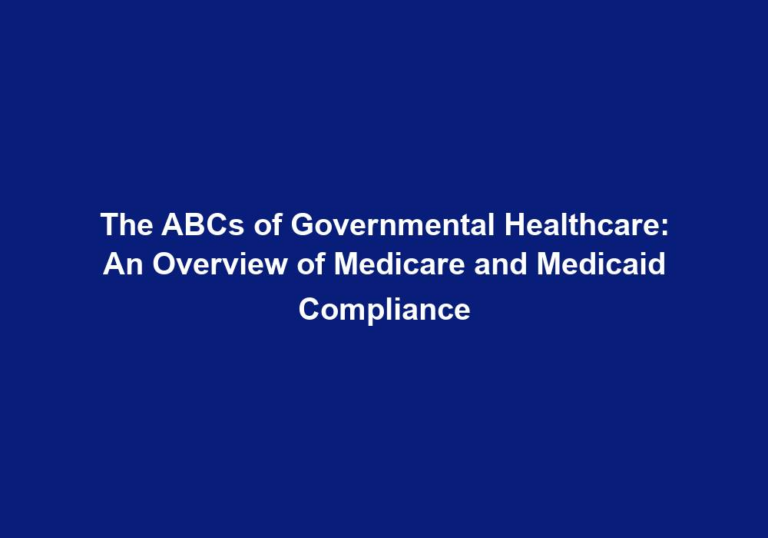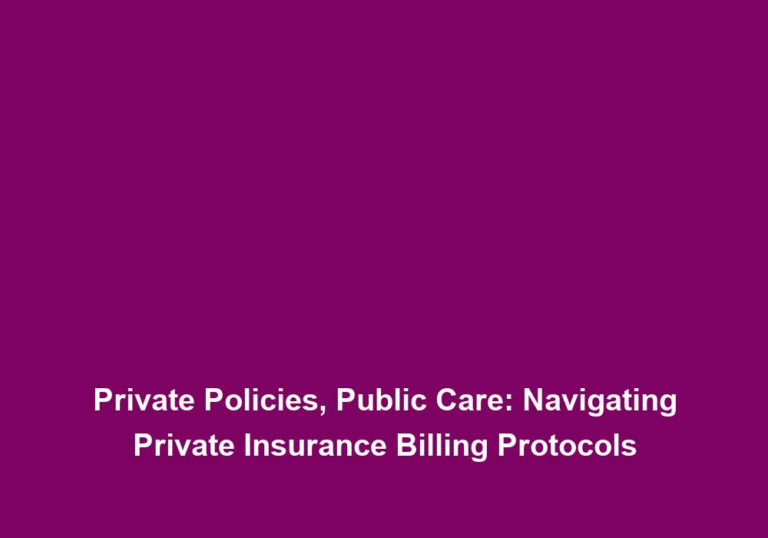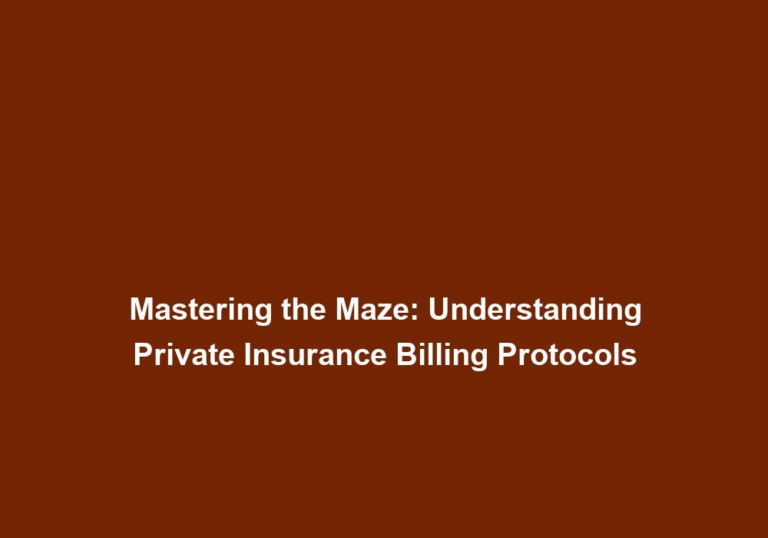Beyond Government Coverage: Best Practices for Private Insurance Billing
Private insurance billing is an integral component of healthcare practices, providing medical providers with the means to receive reimbursement for their services. While government coverage, such as Medicare and Medicaid, plays a significant role in healthcare financing, private insurance offers additional opportunities and benefits. In this article, we will explore the best practices for private insurance billing, ensuring seamless processes and maximizing revenue for healthcare providers.
Understanding the Importance of Private Insurance Billing
Private insurance coverage surpasses the limitations of government-funded programs by allowing healthcare providers to expand their patient base and offer a broad range of services. However, to optimize revenue generation and streamline administrative processes, it is crucial to have a comprehensive understanding of the best practices involved in private insurance billing.
Private insurance billing encompasses several key practices that contribute to its effectiveness and efficiency. By adhering to these practices, healthcare providers can ensure timely reimbursement and minimize claim denials. Let’s delve into each of these practices in detail.
1. Verification of Patient Insurance Coverage
Before providing medical services, it is essential to verify the patient’s insurance coverage. This step helps determine the patient’s eligibility, coverage limits, and any requirements for pre-authorization. By verifying insurance, providers can prevent claim denials and ensure that they receive timely reimbursement.
During the verification process, providers should gather detailed information about the patient’s insurance plan, including the policy number, coverage period, and any specific requirements for obtaining pre-authorization. Additionally, it is crucial to confirm the patient’s demographic details to ensure accurate billing information.
2. Accurate Documentation and Coding
Accurate documentation and coding play a pivotal role in successful private insurance billing. Healthcare providers should maintain up-to-date and detailed documentation of all patient encounters, including the services provided, diagnoses, and any necessary supporting documentation.
By accurately documenting patient encounters, providers establish a comprehensive record that supports the medical necessity of their services. This documentation serves as a foundation for coding, ensuring that claims are submitted accurately and in compliance with industry standards. Proper coding helps avoid unnecessary claim denials and delays in reimbursement.
To ensure accurate documentation and coding, providers should:
- Clearly and thoroughly document the patient’s medical history, including symptoms, diagnoses, and treatment plans.
- Utilize standardized medical coding systems, such as the International Classification of Diseases (ICD) and Current Procedural Terminology (CPT), to assign appropriate codes to each service rendered.
- Include all relevant details in the documentation, such as the duration and intensity of services provided, any necessary medical equipment or supplies, and any complications or additional procedures performed.
3. Timely Submission of Claims
Timely claim submission is crucial for healthcare providers to ensure prompt reimbursement. Delays in claim submission can result in billing errors, claim denials, or even missed filing deadlines. Implementing efficient processes and utilizing electronic claim submission methods can significantly streamline the billing cycle, reducing the risk of delayed payments.
To expedite claim submission, providers should:
- Establish clear protocols and timelines for claim submission within their practice.
- Leverage electronic health record (EHR) systems that facilitate streamlined claim submission processes.
- Regularly review and reconcile claims to identify any potential errors or missing information before submission.
- Stay informed about the specific filing deadlines and requirements of each insurance company to ensure compliance.
By prioritizing timely claim submission, healthcare providers can minimize payment delays and maintain a steady cash flow.
4. Stay Up-to-Date with Insurance Policies and Guidelines
Private insurance policies and guidelines are subject to frequent updates and changes. It is essential for healthcare providers to stay informed about these changes to ensure accurate billing and maximize reimbursement. Regularly reviewing insurance policy updates and participating in training sessions or workshops can help providers stay up-to-date with the latest guidelines.
To stay informed about insurance policies and guidelines, providers can:
- Subscribe to newsletters or mailing lists offered by insurance companies to receive timely updates.
- Participate in webinars or workshops that focus on private insurance billing and policy changes.
- Engage in professional networks or forums where industry colleagues share insights and updates.
- Utilize resources provided by reputable medical billing associations or organizations.
By actively staying informed, healthcare providers can adapt their billing practices to align with current guidelines, reducing the risk of claim denials and improving revenue generation.
5. Effective Communication with Insurance Companies
Establishing and maintaining effective communication channels with insurance companies is crucial for successful private insurance billing. Providers should ensure that they have designated staff members responsible for handling insurance-related matters, including claim inquiries, denials, and appeals. Prompt and accurate responses to insurance inquiries can help expedite claim processing and ensure swift reimbursement.
To enhance communication with insurance companies, providers should:
- Maintain up-to-date contact information for each insurance company they work with.
- Designate a dedicated point of contact within the practice who can effectively communicate with insurance representatives.
- Document all communication with insurance companies, including dates, names of representatives, and details of discussions.
- Follow up on claim inquiries promptly, providing any required additional information or clarifications.
By establishing strong lines of communication, healthcare providers can address any issues or inquiries efficiently, leading to improved reimbursement and reduced administrative burdens.
6. Monitoring and Analyzing Key Performance Indicators (KPIs)
Regularly monitoring and analyzing key performance indicators (KPIs) related to private insurance billing can help healthcare providers identify areas for improvement and implement necessary changes. Some essential KPIs to consider include claim rejection rate, average reimbursement time, and denial rate. By tracking these metrics, providers can optimize their billing processes and enhance revenue generation.
To effectively monitor KPIs, providers should:
- Utilize billing software or practice management systems that offer robust reporting capabilities.
- Regularly review and analyze KPI reports to identify trends, patterns, or areas of concern.
- Benchmark their performance against industry standards or established targets.
- Implement targeted strategies to address identified issues or inefficiencies.
By leveraging data-driven insights from KPI monitoring, healthcare providers can make informed decisions to streamline private insurance billing processes and maximize revenue.
7. Utilize Technology Solutions
Leveraging technology solutions can significantly streamline private insurance billing processes. Electronic health record (EHR) systems with integrated billing modules can automate various tasks, such as claim submission, eligibility verification, and coding. Additionally, using practice management software can help centralize billing processes, improve accuracy, and simplify administrative tasks.
By adopting technology solutions, healthcare providers can:
- Reduce manual data entry and minimize the risk of human errors.
- Automate claim submission processes, ensuring timely and accurate submissions.
- Access real-time eligibility verification to prevent claim denials due to coverage issues.
- Streamline coding processes through built-in code suggestion features and automated code audits.
- Generate comprehensive reports and analytics for performance monitoring and analysis.
Utilizing technology solutions not only enhances operational efficiency but also reduces administrative burdens, allowing healthcare providers to focus more on patient care.
8. Staff Training and Education
Continual training and education for staff members involved in private insurance billing are crucial. Healthcare providers should provide opportunities for their billing team to enhance their knowledge and skills through workshops, webinars, or industry conferences. Keeping staff members up-to-date with the latest coding guidelines and insurance policies can help improve billing accuracy and compliance.
To promote staff training and education, providers should:
- Identify relevant training resources or courses that focus on private insurance billing best practices.
- Encourage staff members to participate in professional certifications related to medical billing or coding.
- Support attendance at industry conferences or seminars to stay abreast of emerging trends and changes.
- Foster a learning culture within the practice by promoting knowledge sharing among team members.
Investing in staff training and education not only enhances individual competencies but also contributes to the overall efficiency and effectiveness of private insurance billing processes.
Conclusion
Mastering the best practices for private insurance billing is essential for healthcare providers seeking to maximize revenue and streamline administrative processes. By ensuring accurate documentation, timely claim submission, effective communication with insurance companies, and leveraging technology solutions, providers can optimize their billing cycles and enhance overall financial performance. Staying informed about insurance policies and guidelines, monitoring key performance indicators, and investing in staff training and education are vital steps towards successful private insurance billing.






